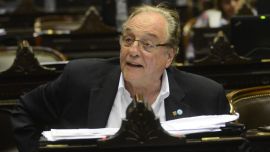It took more than half a dozen extensions, multiple government offers and umpteen hours of virtual conference calls for Argentina to reach a pact with its main creditors on how to restructure more than US$65 billion of international bonds.
The government has now set an August 24 deadline for all creditors to accept it, with a settlement date of September 4. Next up: A new accord with the International Monetary Fund -- and a realistic plan to pull the nation out of economic crisis.
Here’s a timeline of how the agreement, struck on Tuesday, came to fruition:
December 10, 2019 – President Alberto Fernández takes office
January 29, 2010 – Government officials tell investors that they will present a debt sustainability programme.
February 2 – Bondholders continue joining forces in different creditor groups seeking to represent interests in common. Economy Minister Martín Guzmán warns creditors the nation will need a “deep debt restructuring.”
February 19 – IMF staff concludes that Argentina’s debt is unsustainable after a team visits Buenos Aires.
March 2 – Argentina hires Bank of America Corp and HSBC Holdings Plc as underwriters in its debt restructuring and contract Lazard as its financial adviser.
March 4 – Some of Argentina’s largest creditors fly to Buenos Aires for talks with the government, even as the outbreak of the pandemic forces some to cancel trips. The day before, Argentina had confirmed its first Covid-19 case.
March 10 – Argentina includes as much as the equivalent of US$69 billion in nominal foreign-law bonds as part of debt talks with private creditors. The country weighs cancelling a debt roadshow trip over rising coronavirus infections.
April 1 – Talks hit a wall over the grace period in the debt proposal. Argentina wants to start paying in 2024, while creditors want payments to start as early as 2021.
April 21 – The government presents its first debt proposal to the US Securities and Exchange Commission, with a May 8 deadline for creditors to accept an exchange.
April 27 – Argentina starts setting up virtual meetings with institutional investors as they continue the restructuring process.
April 29 – Some bondholders refuse to attend video calls with Guzmán as tension rises on a take-it-or-leave-it offer from the government.
May 7 – Government says it’s open to new proposals from creditors to restructure US$65 billion of debt, signalling a greater willingness to negotiate.
May 10 – Argentina extends its debt deadline to May 22. The government doesn’t disclose what percentage of investors accepted the original proposal.
May 15 – The Ad Hoc Bondholder Group, the Exchange Bondholder Group and the Argentina Creditor Committee submit separate counter-offers to the government.
May 22 – Argentina enters its ninth default after a 30-day grace period expires for coupon payments on dollar bonds maturing in 2021, 2026 and 2046.
May 26 – Deadline extended for a second time to June 2, government says it’s preparing to improve its offer.
May 28 – Argentina submits a new proposal, with a two-year moratorium instead of three. Bonds rally.
June 1 – Government extends deadline to June 12 after the IMF says there’s little scope for the nation to increase payments to creditors.
June 12 – Deadline extended for fourth time, until June 19.
June 16 – The Ad Hoc Bondholder Group and Exchange Bondholder Group submit an offer in which they agree to accept losses on a net-present value basis of about 44 to 46 percent. Argentina rejects it.
June 19 – Nation extends a deadline for a fifth time to July 24 as talks stall.
June 24 – Argentina rejects the legal debt terms proposed by the Ad Hoc bondholder group, which included large funds such as BlackRock Inc and Ashmore Group Plc.
July 2 – The Argentina Creditor Committee submits a revised debt proposal to government officials that would provide US$40 billion in debt relief over the next 10 years.
July 3 – A group of top bondholders considers rejecting a government offer with a lock-up agreement, which would bind their members to also dismiss that offer.
July 6 – Argentina presents an offer that would reduce creditor losses on the bonds’ principal, increase coupons and shorten bond maturities, a deal that Guzmán says won’t be improved further. The Ad Hoc and Exchange bondholder groups says offer falls short. Government extends deadline for talks until August 4.
July 8 – Bondholders shouldn’t expect any more improvements or changes to the country’s debt restructuring proposal, says Guzmán.
July 17 – Government submits a bill that would provide owners of dollar-denominated and dollar-linked bonds issued under domestic law with the same restructuring conditions that holders of overseas bonds are being offered.
July 20 – Argentina’s three largest creditor groups join forces to submit a new bond proposal, while the government says bondholders “misunderstand” the country’s restructuring. Greylock Capital Management decides to support the government’s offer.
July 27-28 – Guzmán says Argentina will seek a new programme with the International Monetary Fund regardless of the outcome of debt talks. Main bondholder groups say they represent more than 50 percent of the country’s overseas debt.
August 2 – Breakthrough comes during a call between Guzmán and BlackRock Inc Managing Director Jennifer O’Neil. They discuss a deal where bondholders would receive an average of about 54.8 cents on the dollar, close to midpoint of the most recent offers from creditors and the government.
August 4 – Government says it struck a deal with key creditors that will provide “significant debt relief” and that interest and capital payment dates for some new exchange bonds were moved earlier to reach the agreement. Bonds rally.
related news
by Sydney Maki & Jorgelina do Rosario, Bloomberg

















Comments